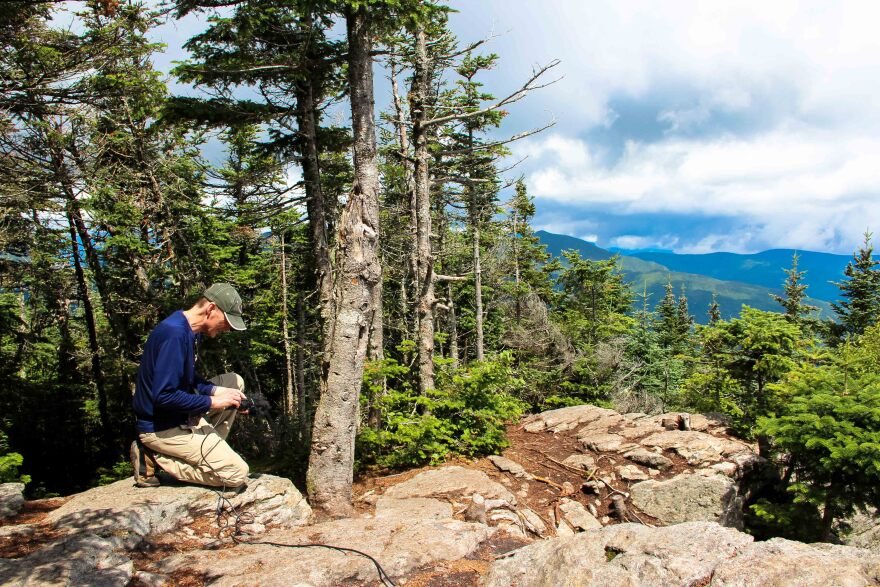Steve Wilkes is a drumming professor at Berklee College of Music in Boston. He’s also a former member of Blue Man Group and has toured the world with The Empire Brass Quintet.
But for his latest gig, as this year’s White Mountain National Forest Artist in Residence, Wilkes won’t be making or teaching music - or painting his face blue. Instead, he’s recording the sounds of the forest and compiling the first ever audio map of the White Mountains.
NHPR’s Sean Hurley joined Wilkes on a recent sound gathering hike and sends us this.
We walk beside the summer quiet chairlift at the Waterville Valley Ski area, Steve Wilkes and I, on our way to the 4,000 foot summit of Mount Tecumseh. “One of the things I wanted to do today,” Wilkes says, “is I just wanted to do a really wide stereo recording of the summit. Regardless of what's there.”
Though Wilkes has only been recording for a few days, his audio map of the White Mountains is already studded with sounds.

From the birds and bugs atop Mount Israel…
To the train and crew noise of the Cog Railway…
Wilkes has done this before – for three years he roved and recorded Cape Cod, creating a sound map of the indigenous and characteristic sounds there for his Hear Cape Cod project.
But here in the forest there have been a few “sound” surprises. “I definitely expected a lot more birds and as we can see on this trail right now, there's not a bird within earshot,” he says.

This lack of bird sound, however, revealed something else. “It's just been so darn quiet,” Wilkes says as we stop to listen to the forest. “You can't find this on Cape Cod. There's nowhere on Cape Cod you will find it this silent.”
I ask him if this quiet is something he can capture well. “I think so,” he says. “Maybe that's one of the artistic challenges of this. You know I'm here recording the forest but how do I get across to everybody else the idea, the quality, of silence - when recording is essentially you know a medium to record the opposite?”
An artistic challenge Wilkes has to face when we arrive on the quiet, windless summit of Mount Tecumseh.

Here’s his recording:
Not absolute silence, Wilkes says, but a way toward it. “Things like insects will oblige and fly by your mics,” he says, “in some ways I think that communicates as silence to people.”
After 10 minutes of recording, Wilkes gathers his gear. “What we just did was an act of music,” he says. “We were taking part in these sounds coming to life around us simply by taking the time to acknowledge them and listen to them and appreciate them.”
We head back down the mountain and Wilkes acknowledges the musical nature of the project. “I'm coming from the standpoint of a musician,” he says. “I can't get away from it. In some way this is all about music to me.”
The music of nature…the nature of music.
The very act of listening, Wilkes suggests, is a form of music - and a good listener a kind of musician. “And I guess that means being a musician is more about how you take things in through the ears,” he says. “How you accept and respect things through the ears at least as much, if not more, than performing something or writing something.”
Wilkes stops to record a brook.

He says that water has been a huge – and unexpected – theme for him in the White Mountains. “The other surprise,” he says, “has just been the people that I've encountered on the trails and especially some of the people that I've been able to record.”
Silence, water, people...Wilkes expected none of these to become his “themes” - which led to some initial uncertainty.
I ask if there was a moment when he recorded something here in New Hampshire and knew his project could work.
“Yeah,” Wilkes says. “On the South Fork of Hancock Branch. I put on the headphones and I looked over at the right channel mic and already a spider had crossed it and left that long thread of a web. And it was glinting on top of the mic in the windscreen in the sunlight. And I'm telling you man I thought, now that is recording. When the spider web starts showing up on your mics, you are in the right place.”
Here then is the sound of a spider web glinting in the sun.
You can listen to all of Steve Wilkes White Mountain recordings on his website Here The Forest.







